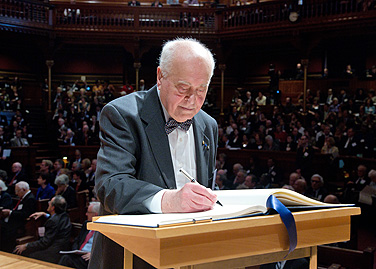News
Ruckenstein inducted into American Academy of Arts and Sciences

Eli Ruckenstein signs the American Academy of Arts and Sciences’ Book of Members, a tradition that dates back to 1780.
UB emeritus faculty member Eli Ruckenstein was among 180 influential artists, scientists, scholars, authors and institutional leaders who were inducted into the American Academy of Arts and Sciences at a ceremony on Oct. 6 in Cambridge, Mass.
The American academy is one of the nation’s oldest and most prestigious learned societies, and an independent research center that draws from its members’ expertise to conduct studies in science and technology policy, global security, the humanities and culture, social policy and education.
Since its founding in 1780, by John Adams, James Bowdoin, John Hancock and other scholar-patriots, the American academy has elected leading “thinkers and doers” from each generation. The current membership includes more than 300 Nobel laureates, some 100 Pulitzer Prize winners and many of the world’s most celebrated artists and performers.
“Induction recognizes the achievement and vitality of today’s most accomplished individuals who together with the academy will work to advance the greater good,” said academy President Leslie Berlowitz. “These distinguished men and women are making significant strides in their quest to find solutions to the most pressing scientific, humanistic and policy challenges of the day.”
Among the new members inducted with Ruckenstein were writer Thomas Mallon; poet Gerald Stern; Stanford university physicist Philip Bucksbaum; Yale University geneticist Richard Lifton; former U.S. Ambassador to Afghanistan Karl Eikenberry; and journalist Judy Woodruff.
Ruckenstein, SUNY Distinguished Professor Emeritus in the Department of Chemical and Biological Engineering and one of the world’s most influential chemical engineers, was a UB faculty member for nearly 40 years. He retired from the university in January.
Ruckenstein conducts both theoretical and experimental research that not only has changed scientists’ understanding of the fundamental phenomena of chemical processes, but has led to the development of enhanced research methods and new materials.
He was the first UB faculty member to receive the coveted National Medal of Science, considered the U.S. equivalent to the Nobel Prize, which is bestowed on individuals who have made outstanding contributions to knowledge in the chemical, physical, biological, mathematical, engineering or social sciences.
He also was the first full-time professor in the SUNY system to be elected to the prestigious National Academy of Engineering, and he later was named the 2004 recipient of its Founders Award, which the organization says recognizes “the elite of the NAE.”
Distinguished engineers who have lauded his many accomplishments repeatedly mention the unprecedented breadth of his work.
Ruckenstein has made groundbreaking contributions in such areas as transport phenomena, the stability of nano-sized liquid and solid films, and thermodynamics of complex systems. He pioneered the theoretical and experimental treatment of the stability of supported metal catalysts, and developed the first kinetic theory of nucleation, theories for colloidal forces and theories in molecular thermodynamics. He also invented new synthetic methods for preparing polymeric membranes and polymeric catalytic particles.
He has published more than 900 scientific papers and 10 patents have been issued based on his research. One of them, which covers new materials he developed with interesting thermal and rheological properties, was licensed by IBM and has been used in the company’s computers.

Reader Comments